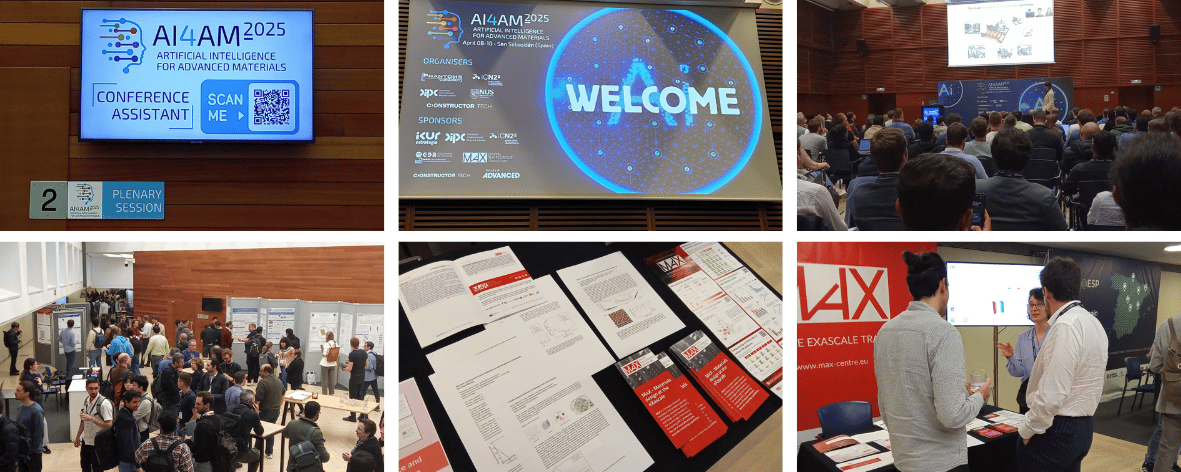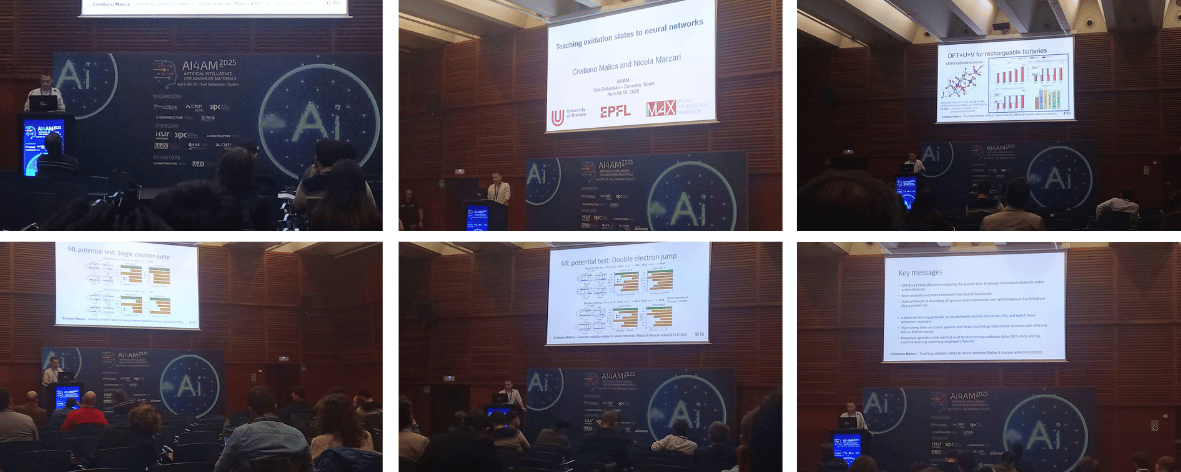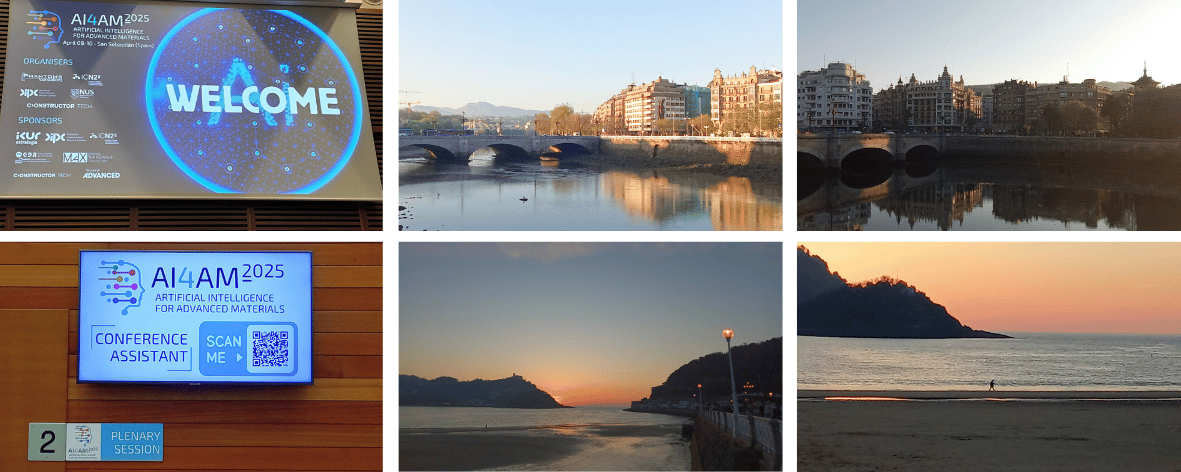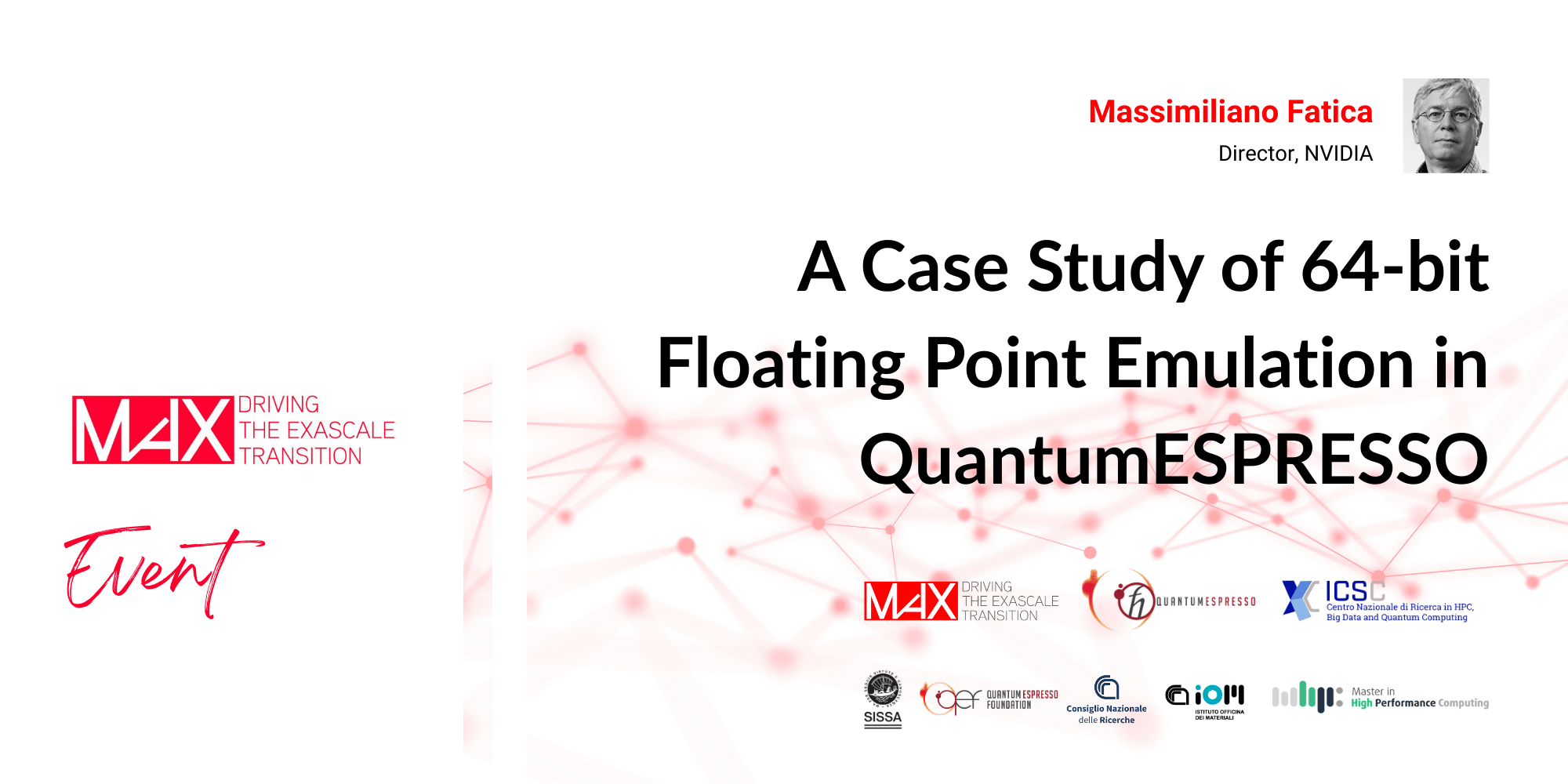MaX Silver Sponsor of AI4AM2025: Advancing AI Applications in Materials Science
MaX Centre of Excellence was proud to be a Silver Sponsor of the Artificial Intelligence for Advanced Materials 2025 (AI4AM2025) conference, which took place from 8 to 10 April 2025 in San Sebastián, Spain. This international event brought together leading experts from industry and academia who are leveraging Artificial Intelligence (AI) to enhance materials research and innovation.

AI4AM is a cross-disciplinary international event that brings together top experts from industry and research institutions using AI techniques, including machine learning, deep learning, and neural networks, to advance materials science. This year’s event focused on the refinement of automated designs for structural and electronic material models in engineering. It also aimed to enhance interoperability among material databases and foster advancements in reverse material engineering. Key application areas included electronics, composites, energy, (bio)medicine, and quantum computing. This second edition of AI4AM successfully strengthened collaborations and industrial partnerships within the global materials science community.
A key highlight of the conference was the Lavoisier Discussions, which addressed the role of AI in 2D materials production, characterisation, and design. With AI playing an increasingly crucial role in materials research, the Lavoisier sessions featured talks and roundtables on how AI-driven approaches are transforming the field.
This year, MaX Centre of Excellence supported the conference as a Silver Sponsor, reinforcing our commitment to enable materials science research through the integration of AI and High-Performance Computing (HPC). By engaging in AI4AM2025, MaX strengthened collaborations with leading experts in academia and industry, ensuring that its research remains aligned with cutting-edge technological advancements.

MaX Partners' Contributions at AI4AM2025
Several MaX partners contributed to the scientific discussions at AI4AM2025:
1) Elisa Molinari (Università degli Studi di Modena e Reggio Emilia, Italy) delivered an invited talk on “Community codes at the exascale for advanced materials”, where she presented the MaX lighthouse codes. Developed openly and collaboratively, MaX codes represent a strategic investment in software innovation and scientific productivity. MaX is working to optimise its lighthouse codes for pre- and exascale architectures, ensuring their scalability on heterogeneous GPU-based systems and improving their deployment and performance on EuroHPC platforms. In this process, the role of the developer community is essential to guarantee code quality, maintainability, and scientific reliability, as highlighted by Molinari in her talk. Beyond code performance, MaX addresses the growing need to integrate experimental and computational data. To this end, MaX is working to integrate AI methods into first-principle simulations to accelerate predictive materials modelling and discovery. Yet a question remains: can we take MaX community codes for granted? Are these codes, however advanced, sufficient on their own to meet the demands of materials discovery and design? The answer is clear: high-quality, interoperable, and consistent data are fundamental. It is only through the combination of robust codes with curated data and intelligent algorithms that the full potential of computational materials science can be realised.

2) Nicola Marzari (EPFL, Switzerland) was invited to present "The electronic-structure genome of inorganic materials" as part of the Lavoisier Discussions. His talk focused on how maximally localised Wannier functions (MLWFs), widely used in computational materials science, can be systematically constructed through automated algorithms. He showcased MaX databases of over 20,000 3D inorganic crystals and 2,000 exfoliable 2D monolayers, which serve as an "electronic-structure genome", a minimal but precise encoding of materials' electronic structures. These databases enabled accurate calculations of materials properties and supported applications such as high-performance thermoelectrics, topological materials, and 2D heterostructures.
3) Cristiano Malica (University of Bremen, Germany) presented "Teaching oxidation states to neural networks". His research demonstrated how extended Hubbard functionals (DFT+U+V) can improve the description of redox reactions and oxidation states in materials. He discussed the development of redox-aware machine-learning potentials, trained using AI models that integrate oxidation state information. These advances were particularly relevant to rechargeable battery technologies, where accurate redox state predictions are essential.

MaX Presence in the Exhibitors Area
As a Silver Sponsor of the conference, MaX had the opportunity to showcase its brand and project outputs through a booth in the Exhibitors area. This presence was crucial to increase the project’s visibility within both academia and industry, fostering engagement with researchers and industry professionals, and promoting knowledge exchange on AI-driven methods and applications for materials research and innovation.

Integrating AI methods and technologies to enhance materials research.
AI allows for more efficient analysis of complex data sets, enabling researchers to predict material properties, behaviors, and performance with higher accuracy. This integration can significantly reduce the time and cost involved in experimenting with new materials, as AI can identify promising candidates more quickly than traditional methods. Additionally, machine learning models can uncover patterns and insights from large-scale datasets that might be difficult or impossible for humans to detect. As a result, AI is helping to accelerate innovation in fields like energy storage, electronics, and pharmaceuticals, where advanced materials are critical. At the booth, MaX showcased the most recent developments of its partners working on AI applications in materials research:
-
Design of Materials: Polymer networks (EVIDEN in collaboration with LIPhy lab - CNRS/Université Grenoble Alpes)
-
Machine Learning approach on GW calculations (YAMBO, CINECA, CNR-Nano, UNIMORE)
-
AiiDA-TrainsPot: automated learning of neural-network interatomic potentials (SISSA, QuantumESPRESSO)
-
Testing AiiDA scalability towards the exascale (SISSA, QuantumESPRESSO)
-
Towards an exascale AiiDA-TrainsPot workflow (SISSA, QuantumESPRESSO)
-
Graph2Mat: A graph to matrix converter for DFT calculations (ICN2)
-
Machine Learning Interatomic Potentials for Photovoltaic Perovskites Materials (SISSA)
-
LATTE: Local Atomic Tensors Trainable Expansion; an efficient atomic descriptor for MLIP (SISSA in collaboration with NVIDIA)
-
A flexible network architecture for managing multi- species datasets (SISSA)
-
Machine Learning Interatomic Potential to model Graphene-air interaction for drag reduction (SISSA)
-
Developing Machine-Learning Interatomic Potentials including electrostatics (SISSA)
-
Teaching oxidation states to neural networks (UBREMEN in collaboration with EPFL)
-
Machine Learning models for the simulation of X-ray spectroscopies (QuantumESPRESSO, UNIMORE, CNR-Nano)
Enhancing computational materials science through AI and HPC
The AI methodologies showcased at AI4AM2025 demonstrated the transformative potential of machine learning in materials discovery and optimisation. Yet a crucial question remains, highlighted by MaX Coordinator in her talk: can we rely solely on MaX community codes to address the complex challenges of materials discovery and design? While these codes are powerful and continuously evolving, they are not sufficient on their own. Achieving meaningful scientific progress requires more than just advanced software; it demands access to high-quality, interoperable, and coherent data. The true potential of computational materials science will only be unlocked through the integration of performing simulation software, curated datasets, and intelligent methods such as Machine Learning and AI.
By working on automated AI-driven workflows, machine-learning-enhanced materials databases, and accelerated electronic structure calculations, MaX aims to enable more efficient and accurate materials simulations and design. In the next two years of the funding phase, MaX will continue to leverage AI and HPC to enable frontier materials research and innovation.
For more details on the conference, please visit the official AI4AM2025 event website.




